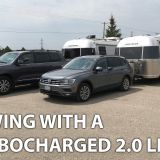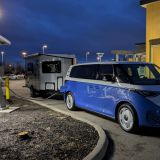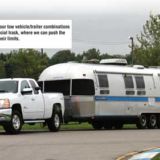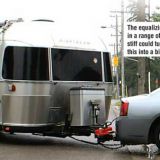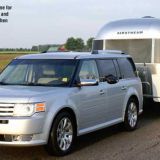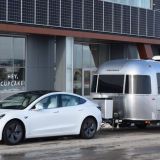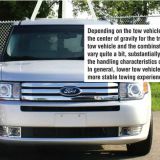
Boondocking, Definition: Camping without amenities, being self sufficient without access to water, sewer or electrical. This often occurs in backcountry camping as well as rest stop and parking lot camping.
I thought I would share our experiences boondocking in the Wawa, Ontario area a couple of weeks ago. We had the opportunity to get together for a week of camping with family and friends for a reunion of sorts at a beautiful location, way off the beaten path on the shore of Lake Superior. My previous experiences in this part of the province involves memories of running from a multitude of biting insects, unseasonably cold weather and mud. I had my fingers crossed that history was not going to repeat itself. It was quite a drive in on some rough gravel roads and our Dodge minivan pulling our 25 foot Airstream worked hard on the steep grades but we got there with no problems. Much of the rest of our group were camping in tents and had found nice shady sites among the trees to set up camp. I found a nice level spot on open ground with a spectacular view of Lake Superior and we were treated to an everchanging view as the days progressed. The price we pay for this perfect site is that this is not a campground and there is no water, electric or sewer connections available anywhere.
In preparation for this I arrived with a full tank of fresh water, empty holding tanks and plenty of propane. I also had an extra five gallons of drinking water in the van and a portable waste tank, commonly known as the "blue boy", not to be confused with the Gainsborough painting of 1770.
Part One: Power and Power Management
Our Airstream itself does not have Lithium batteries or any upgrades for solar. The only improvements we have made to the trailer to extend battery life is to replace all the standard light bulbs with LEDs. This is of course standard on newer units. My solar set-up is a little less traditional. Because we have more than one Airstream I did not want to put panels on the actual trailer. My 170 watt panel is mounted to the roof of the tow vehicle and this has several advantages in my opinion. The main benefit is that I can provide solar energy to whatever trailer I am towing and when we buy another Airstream we will be ready to go with no alterations to the trailer. The tow vehicle mounting means that the Airstream did not have to have any extra brackets attached or cables run into it with the risk of water infiltration down the road. My roof is easier to clean and move around on as well.
My solar panel is attached to the factory cargo rack of our Dodge Caravan. The cables run into the drivers side sliding door and do not create any problem being in the way of entering or exiting. I used this exact method on our previous tow vehicle, a Suburban, quite successfully for years.

I have extension cables that give me approximately 20 feet of cable that run to my solar controller, and then another 6 feet of cable to the batteries of the trailer itself. All connections are quick release and set up takes mere minutes.
The biggest advantage of my set up is that if you are off grid with no air conditioning it is a good idea to park in the shade. If your solar panels are on your trailer you will not be getting much power from the sun.
If your solar panels are on the tow vehicle you can likely park in the sun near your trailer and get full solar power.
On our Wawa trip, despite a couple of cloudy days, we had no problem keeping our batteries topped right up with our solar panel.
I have one other recomendation that is working well for us. I have a Portable Power Station that we keep in the mini-van. This thing is super practical. Ours is an EcoFlow, but other well known brands are Jackery and Bluetti. Prices start at about $200 and go up from there depending on the wattage you require. When I am not using our solar panel to charge the trailer it is busy keeping our EcoFlow charged up. Our van also has a 110 volt inverter that you can plug the Power Station into and charge while you are driving without using solar. That is handy on a rainy day!


When we are off to the beach or the grocery store the Power Station runs our portable cooler. I also use it to charge all our devices when we are camping so I can preserve the trailer batteries for running the fridge and water pump and lighting. You can take the Power Station with you to the picnic table or backyard to run lights or nearly anything at all.
That is how we are utilizing solar power when boondocking. I do have a plan B in case we get a few days of cloudy or rainy weather and if you are stuck inside you tend to use more power. We also have a great gadget called Car Generator. It hangs on the front of your vehicle and connects to your vehicles battery. This is a super efficient invertor that provides clean 110 volt power that I can plug our trailer in to recharge the battery and run most household voltage equipment. Mine puts out 1100 watts and that gets me everything I need except air conditioning. My Car Generator has also "saved my bacon" during power outages at home keeping power to my freezer and furnace when needed. We sell this product at Can-Am RV Centre and you can read more about it on their website. See the link at the end of this article.
As far as managing our power efficiently it really comes down to being careful about using the minimal amount of lighting at night and always remembering to turn lights off. For me, those in closet lights and cargo lights are the ones I miss. The light over the stovetop is another one I can forget to turn off. At night I use battery powered lights on our site instead of the outside lights on the Airstream. If I am really trying to conserve energy I don't use the on-board invertor to run the tv or coffee maker. If we really need a television fix we watch movies on a laptop and use a french press to make coffee. The laptop gets charged with the Power Station.
Part Two: Water and Waste Management
If you are going somewhere without fresh water readily available make sure you have your RV tank full. As I mentioned earlier we also bring a big jug of drinking water for making coffee, tea and brushing teeth. This saves the RV fresh water for showers, washing up and doing dishes. Again it really just comes down to being careful with your resources. Short showers and turning off the water until you are ready to rinse off. If you are really concerned you may run out, use disposable paper plates (not styrofoam or plastic). On our recent trip, the gang had a dish washing table set up outside with bins of soapy and rinse water and we used that quite a bit of the time which saved both our fresh water and grey water reserves.
Another tip for saving both water and even more importantly extending your black water holding capacitiy is to turn off the water to your toilet. Wait, don't panic yet! Your toilet likely has a valve or tap behind it to turn off the water for flushing the toilet. Not only is that extra water being used up, but more importantly you might be filling up your black water tank. Depending on the size of your family this could happen faster than you think!
My advice is that you keep a spray bottle of water, with a bit of cleaner in it beside the toilet. Flush and give the bowl a good spray afterward. This will keep a bit of water in the bowl to keep the seal from getting dry and save space in the black tank. There are times you will need to turn on the water and give it a good flush, but maybe not every single time. When you are off grid, every little bit of caution helps.
But, if you do need to empty a black tank or grey tank that is where the "blue boy" comes in handy. This is a portable waste tank on wheels with a fitting that connects to your waste valve. Most tanks can even be connected to the ball on the tow vehicle to drag it over to a dump station or outhouse to be disposed of properly. Never, ever dump black water on the ground! If you have a smaller trailer or B van you may have only one tank that combines black and grey water. In this case you have to be really careful about filling up your tank too quickly. Doing dishes outside at the picnic table and public showers, if available, would be a good idea.

So we did indeed stay self contained at Wawa for six days. We never had to use the Car Generator and we didn't even come close to using up our water. Our waste tanks worked well and I was happy to not have to use the "blue boy". I even think we may have been good for a couple more days if we had to. It was a great experience to have our rig performing exactly like it was designed to do and we were SO much more comfortable than the folks out in the tents. And it gets cold at night in Wawa next to Lake Superior in August! Call me a softy, but I ran the furnace one night before bed to warm the place up! I am happy to report that the bugs were nearly non-existent and the bit of light rain we had mid-week didn't turn the place into a bog. I am looking forward to the next boondocking adventure in northern Ontario, and really don't miss being off the grid at all.
Can-Am RV Centre has extensive experience with solar set ups that will fit every need and budget. Contact the parts department and get some expert advice. Being able to camp off the grid opens up your travel plans to so many more opportunities. Happy Trails, Michael and Tina Lambert
Link to Car Generator: Click Here
Can-Am RV Centre Parts Department: Click Here


